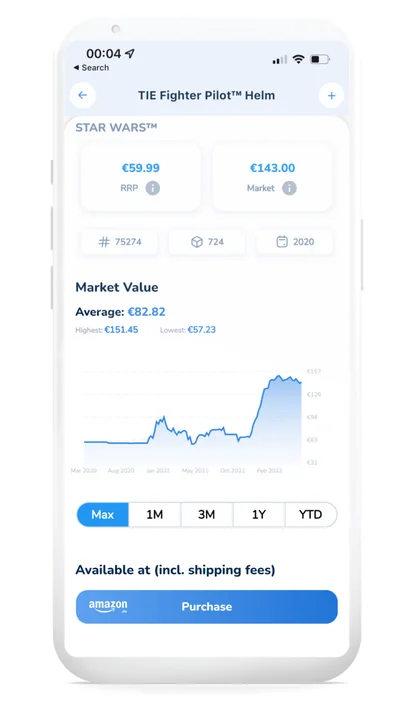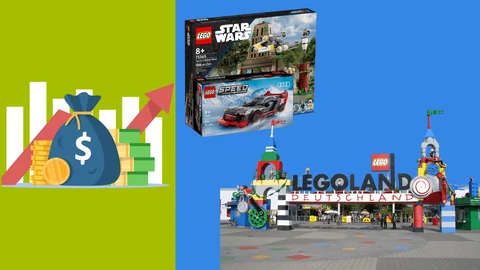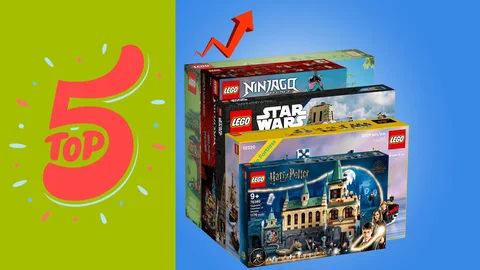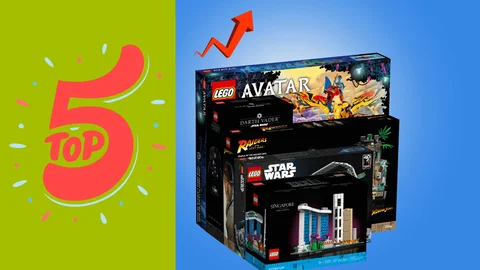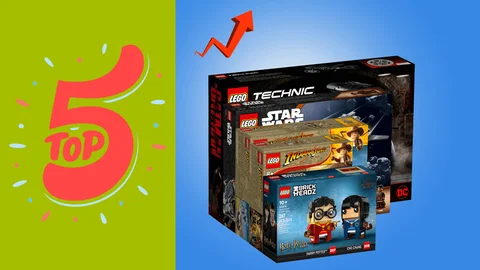Investing in Lego®? For many, this may sound extremely new, after all, the terminal bricks are toys for children. So it may surprise many that there are entire communities of adult enthusiasts worldwide who invest in Lego. For a long time now, children have no longer been the main target group of the Danish Lego Group. Lego is discovering adult fans and collectors more and more and today every tenth euro is earned in the adult target group.
But why are Lego sets suitable as an investment at all? Lego sets are generally only produced for a limited period of time. After a set disappears from the market, experts talk about it being "End of Life" (EOL). When a set "goes EOL", i.e. is no longer produced, the price usually rises quite quickly because the supply decreases, but nostalgics and fans still show lively demand for the set. Lego investors buy popular sets cheaply while they are still regularly available on the market and then sell sets after the EOL for a higher price to collectors and fans.
On the Brickfact Blog, we go into more detail about why Lego sets can rise in price and all the things you need to consider when investing in Lego.
The rising popularity of Lego investors has also attracted the interest of academia: a study by Russia's HSE University of Finance analysed the performance of thousands of Lego sets from 1987 to 2015 and found that the average return over this period was better than that of gold and stocks.
We explore this exciting topic in this article and compare investing in Lego with investing in shares or gold.
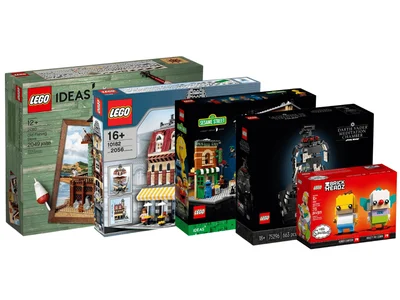
Lego® return vs. shares and gold
The return is an important factor for asset classes. Particularly in times of high inflation, the return on investment is responsible for the preservation and growth of the invested capital. In the following, we compare the return on Lego investments with the return on shares and gold.
Constant value increases with Lego®
According to the aforementioned study by the HSE University, Lego sets showed an average return of a remarkable 11% per year in the period from 1987 to 2015. This value is very strong, but it is also an average value and certainly not every Lego set performed well. With a bit of know-how, good sets can be distinguished from worse ones in order to be successful in Lego investing. Moreover, the Lego appreciation is very constant even in crisis years. As a rule, building sets based on films or landmarks show a particularly good performance, according to the researchers. Equally interesting are themed series that appeal to the adult target group. One example is the Lego IDEAS Theme world.
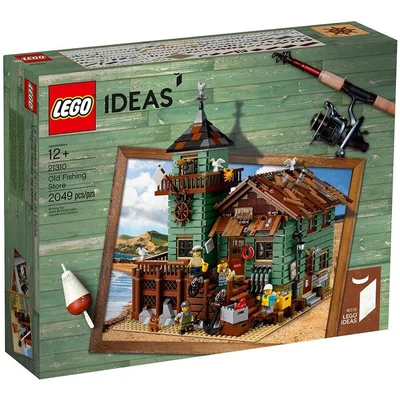
In addition to the aforementioned study, we would like to illustrate the Lego increase in value with an example: Lego® Ideas 21310 Old Fishing Store was released in 2017 and went EOL at the end of 2018. Until today (as of the beginning of June 2022), the Old Fishing Shop can show a value development of a proud 34.80% per year.
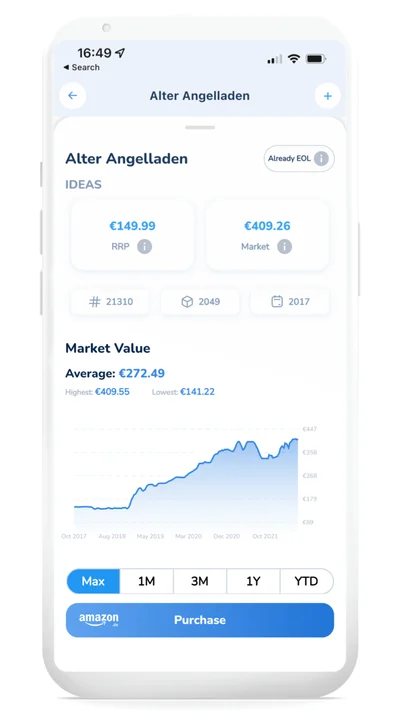
Are you interested in investing in Lego? In the Brickfact app and on our website you can view the performance of thousands of sets. Of course, the whole thing is completely free of charge and without advertising. The Brickfact app is available for iOS and Android.


Gold: Yield only slightly above inflation
Gold is probably the oldest and best-known store of value. The precious metal was already used as a currency and store of value in ancient times. Even today, gold is attributed an important significance. As a frequently titled crisis currency, the average return on gold, according to Gerd Kommer, was 3.3% annually between 1970 and 2014. This means that gold is clearly inferior to the investment Lego in terms of return. Especially considering the average German inflation rate in the period from 1960 to 2021 of 2.6% per year. Historically, the gold price has also had long negative phases. At times of high inflation, however, the price is boosted again.
Returns with shares are crisis-prone
Those who invested their capital in a broadly diversified equity portfolio in 1987 can look forward to an average return of 8.48% per year to this day. This is derived from the MSCI World Market Index, which comprises more than 1,600 globally active companies and is considered a good representation of the equity asset class. The return of shares is therefore better than that of gold, but slightly inferior to the return of Lego®. It should also be noted here that the return on equities depends on real value creation by the companies, whereas gold and Lego are not subject to "value creation", but investors hope for buyers who are willing to pay a higher price. In contrast to Lego and gold, shares can generate cash flow through dividends even without a sale.
Tradability: Lego® vs. shares and gold
In addition to the return of an asset class, the tradability or liquidity of an asset class is relevant for investors: If an asset has increased in value and the investor wants to sell it, there must also be demand for it on a corresponding trading venue. Without this, it is obviously difficult to realise the profit.
Simply sell Lego®?
The biggest increase in value of Lego sets is over 2 to 3 years after EOL. After this period, investors usually consider selling.
In order to sell the Lego® sets, a sales platform is needed first. Possible platforms that are suitable for selling Lego sets are, for example:
- Amazon
- eBay
- Bricklink
A sale on these platforms happens quite quickly, depending on the popularity of the set. Compared to other alternative asset classes, Lego is very liquid and investors usually only wait a few days to a few weeks for a sale. In addition, Lego sets are uniform and not individual like, for example, cars or art. This makes the sale and the valuation less complicated. However, when investing in Lego, you are dealing with physical products that have to be packed and shipped. This is correspondingly more costly than trading in shares or gold.
Gold: Sale on stock exchanges possible
With gold, we distinguish between physical and virtual gold. The best known is certainly the physical trade with coins or bars. Due to the constant demand, trading is quite simple and quick. Virtual gold such as gold ETFs or certificates are traded on exchanges. This may incur fees and brokerage costs, but trading is very simple and can be completed within minutes. Since gold is very uniform, however, even the physical tradability is superior to the Lego asset class.

Shares: Winners of tradability
As one of the most popular forms of investment of all, trading in shares is uncomplicated and often self-explanatory. Shares are traded on stock exchanges for a fee, similar to virtual gold. It is important to note the corresponding stock exchange opening hours. The stock markets are characterised by high liquidity, which means that shares can be sold very quickly and efficiently. Exceptions, however, are times of crisis, when shares are often no longer tradable and investors can no longer sell their securities. In contrast to Lego® or gold, one always needs an open stock exchange for shares. All in all, however, the tradability of shares is superior to that of Lego and also gold.
Lego® storage vs. shares and gold
In this section, we compare the three asset classes in terms of their safekeeping requirements.
Lego® storage requires space
Store Lego in a space-saving and safe way: This is the art of every Lego investor or collector. To ensure that nothing happens to your Lego sets, it is important to store them properly. When selling, collectors pay close attention to the condition of the original packaging. It should never have been opened. Signs of use such as dents, cracks or fading should be avoided. Any significant sign of use reduces the later sales value and thus the return on investment. In addition, a separate room or warehouse is usually needed to store large quantities of the colourful sticky bricks. In the Brickfact Guide 10 tips to manage your Lego® collection, we have summarised how to store Lego® correctly and in a space-saving way.
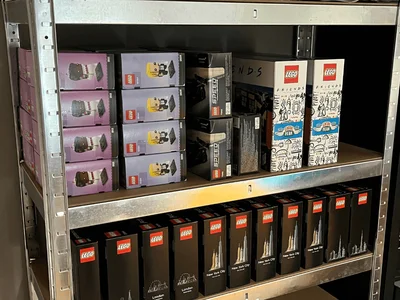
So keeping Lego requires some knowledge and effort to make investing successful.
Gold: physical or in a custody account?
In contrast to Lego® sets, storing physical gold is less complicated, but also not necessarily cheap. Safes are suitable for small amounts of gold. If you want to be on the safe side, it is advisable to rent a safe deposit box and also take out insurance. Storing virtual gold, on the other hand, is much easier. Your broker takes care of the storage for you and the storage is much easier than with Lego.
Shares: Custody at the bank
In today's times, it is a matter of course to be able to store shares securely digitally. A few decades ago this was different: securities were kept in paper form and gold exclusively in coins and bars. In the 21st century, shares are fortunately stored safely in digital form at a securities clearing and deposit bank.
Moreover, shares are part of the special assets and are thus secured even without insurance. Compared to gold and Lego®, the storage of shares is thus superior to both asset classes.
Lego® risk vs. shares and gold
"Never put all your eggs in one basket!" or "Broadly spread, never regretted!" - These are well-known stock market sayings. With investments, the risk should always be compared to the corresponding return. In this section we look at the risk factor for Lego®, shares and gold.
Lego®: Risk and high return?
As you have already learned, the condition of the original packaging of Lego® sets is important. The better it is, the more profit you can expect when selling. For larger sums, you should therefore take out inventory insurance to protect your Lego investments from external damage. In case of an emergency, you will get the value of the Lego sets back from your insurance company. This way you can reduce this risk.
Another risk is the re-release of sets, which can be well illustrated with an example: Lego® Ideas 21309 LEGO® NASA Apollo Saturn V went EOL in December 2019. However, it was then reissued in the same form under set number 92176 in early 2020. This led to a significant drop in value for the previous model.
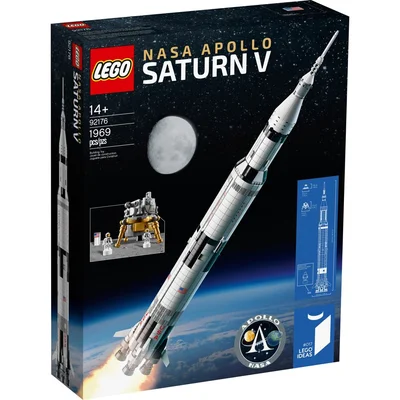
The following graph shows the performance of the first Apollo rocket very well: You can see the rise after EOL and the prompt drop in value after the announcement of the new launch. Fortunately, such scenarios are rare.
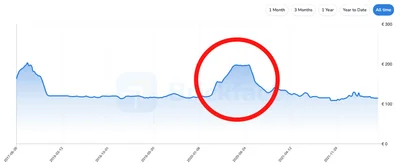
Lego investors must therefore trust that the Lego company will avoid new editions as far as possible.
Another point of risk is the general economic situation. According to the study by the Russian researchers, the Lego asset class largely defies crises - quite in contrast to shares.
Gold: Fluctuations and currency risks
There is a currency risk with gold, as the gold price is linked to the US dollar exchange rate. However, this risk is low because the dollar is one of the safest currencies of all. As with Lego sets, there is a risk of theft with physical gold. Safekeeping is therefore indispensable, but it also costs money. In addition, counterfeiting is a potential risk with physical gold. Especially for laymen, it is often difficult to tell the difference. So, as with Lego, there are substantial risks that investors should be aware of before investing in gold.
Shares risk
Wirecard: One of the prime examples of the real risk of the asset class of shares. Scandals can quickly lead to insolvency and a total loss of individual shares. It is well known that ETFs are a better choice here, as they significantly reduce the risk of a loss through broad diversification.
In addition to the insolvency of individual companies, financial crises and the stability of individual countries and regions also represent risk factors. For example, those who invested their capital predominantly in Russian shares in recent years are now facing a considerable loss in value. Nevertheless, if you are smart about investing in shares and invest for the long term, you can achieve a good return with comparably manageable risks.
Lego® Investment? As a supplement!
That was them: A comparison of the three value investments Lego®, gold and shares. Clearly, each of these three value investments has its advantages and disadvantages.
In terms of returns, Lego investments are superior to the other two asset classes. With an average return of 11% per year between 1987 and 2015, the sticky bricks offer an attractive investment opportunity. Thanks to good data, it is foreseeable when Lego sets will cease to be produced and subsequently rise in value. The past has shown that especially adult sets are a good investment. The return on gold, on the other hand, has been by far the worst in recent decades. Shares show a solid return with moderate risk.
Trading shares or virtual gold is uncomplicated and very inexpensive. In contrast, Lego investments require a certain amount of effort.
Selling Lego sets requires a certain amount of effort, whereas virtual gold and shares can be sold cheaply.
There is no such thing as a perfect investment, and Lego sets are definitely a good addition to a diversified portfolio. In the end, however, one should not lose the fun in investing money.
Our favourites for a Lego® investment
Are you wondering which Lego® sets could be particularly worthwhile for investments? In the Brickfact app you have the possibility to filter specifically for "investment tip" and find suitable Lego sets.
